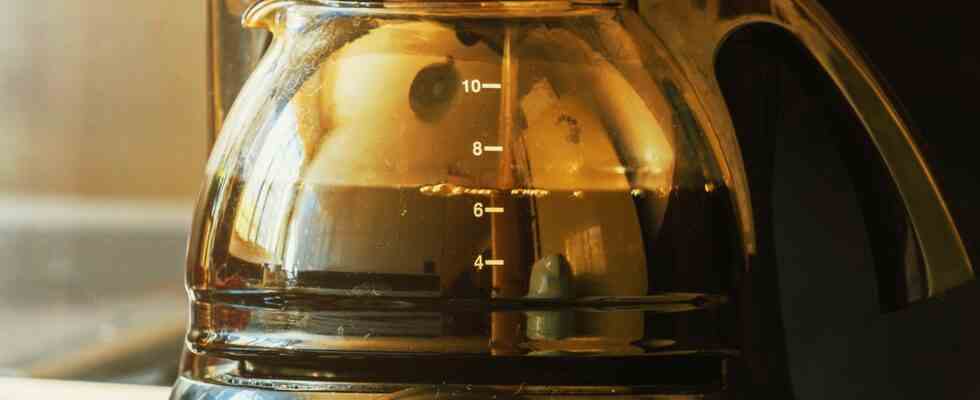household tip
Cleaning the coffee machine: How to get rid of limescale and crumbs quickly and reliably
The coffee drips quickly and reliably from ordinary filter machines into the pot. The disadvantage: the glass containers are susceptible to limescale and have to be cleaned regularly by hand. Cleaning the coffee machine: This is how it works.
© simonmayer / Getty Images
Limescale stains on the coffee pot are not only ugly, they also spoil the taste and mood of coffee fans. It is all the more important to clean your beloved coffee machine regularly. Read here what you should consider.
The Germans love coffee. Hectoliters of it is prepared and drunk daily in all variations. For that much-needed caffeine kick, because high-quality coffee simply tastes good, or simply because of years of habit. In times of the corona pandemic, the brown gold is mainly cooked in the mobile offices of German employees. In contrast to the elegant fully automatic coffee machines in the office, the good old filter coffee machine is still used in addition to smaller portafilters and espresso makers. This usually works reliably, but has one disadvantage: it has to be cleaned by hand. In continuous operation, glass or thermos flasks groan under penetrating limescale residues and edges – and hundreds of annoying coffee crumbs cavort in the container for the filter.
In the following article you will find out how to clean your coffee machine quickly, reliably and cheaply.
All-purpose weapon Citric acid: That’s the catch
Powdered citric acid is not only one of the most popular limescale killers for bathrooms and toilets. The inexpensive all-purpose weapon is also a reliable helper in the kitchen. In addition to pots and pans, the versatile powder can also be used to remove limescale from your in-house coffee machine. But be careful: If you heat citric acid to more than 60 degrees, a white, sticky mass is formed – calcium citrate. This settles in the machine and hardly ever goes away. Pure citric acidSo running it (mixed with water) through a coffee maker is not a good idea. If you want to buy a new coffee machine, you can register in this current one Coffee machine test inform about current models.
Citric acid should therefore always be mixed with cold or lukewarm water. Then the limescale killer is ready for use. Mix the powder with water to a pulp, grab a clean paintbrush and carefully paint the inside of the coffee maker with it. Leave it on for 30 minutes and then rinse the machine twice with hot water. This variant is doubly effective: the citric acid pulp loosens stubborn dirt and coffee crumbs, and the coffee machine is descaled at the same time.
If you don’t have anything else in the house, you can use vinegar essence to descale the coffee machine. The principle is simple: Run two parts water and one part vinegar through an empty paper filter. Because vinegar doesn’t give limescale a chance, but can also damage other components due to its aggressiveness, many machine manufacturers advise against using vinegar-based cleaners, especially for devices that work with pumps.
An ordinary coffee machine is not enough for a cultivated latte macchiato or a cup of fine cappuccino. This is where the time comes for the fully automatic coffee machine, which is becoming a regular fixture in more and more German kitchens. If you are still thinking about it, you can Fully automatic coffee machine test 2021 inform.
Cleaning the coffee machine: Let the professionals do it
Vinegar essence here, citric acid here. If you want to reliably clean and descale your coffee machine, you should let a professional do it. Many manufacturers have now developed professional descalers for coffee machines. With filter coffee machines, it is worth going to one Liquid descaler to grab. Prepare the solution according to the instructions, place an empty filter bag in the insert, switch on the machine and off you go. To increase the effect, the machine can be switched off when half of the descaler has run through. Pay attention to the information provided by the manufacturer.
Important: The water tank should then be filled at least two to three times. Only when clear water has been flushed through all the pipes several times does the coffee taste delicious again.
The jugs of coffee machines, especially glass jugs, are also susceptible to dirt. In addition to limescale, which sticks to the floor or walls, especially if the water is very hard, coffee residues are also likely to burn into the glass. The dishwasher doesn’t stand a chance in this case. A simple trick can help. Fill the glass jug with boiling water and dissolve a small piece of dishwasher tab in it. Let it take effect for a few minutes, wipe carefully with a sponge or cloth, and you’re done. Before brewing the next coffee, the pot should be rinsed out again with clear, hot water.
Sources: “happycoffee.org”, “frag-mutti.de”
You might also be interested in:
This article contains so-called affiliate links. Further information are available here.

